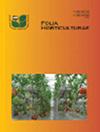硫酸锌或纳米锌在四季豆叶片上的应用
IF 2.2
4区 农林科学
Q2 HORTICULTURE
引用次数: 13
摘要
摘要绿豆(Phaseolus vulgaris L.)是一种种植广泛的粮食作物,由于其蛋白质含量高,在许多国家对人类饮食需求做出了重大贡献。本研究评估了ZnSO4与氧化锌纳米颗粒(ZnO NPs)在绿豆“Strike”叶片上的叶面应用,并记录了植物对锌的吸收以及光合色素和生物活性化合物的浓度。该实验在墨西哥奇瓦瓦的温室条件下进行,采用完全随机的实验设计,共有10个重复。这两种处理是ZnSO4水溶液或ZnO NP水悬浮液(均为150 mg·L−1)的叶面施用。ZnO NPs的施用显著增加了叶绿素a和叶绿素b的小叶、根、茎和荚中的Zn2+浓度(分别为15.40μg·g−1和11.64μg·g-1)。Zn2+的应用也增加了蔗糖的浓度,但总酚(TP)、总黄酮(TFl)或抗氧化能力(AC)没有差异。在荚和种子中,施用Zn2+使蔗糖和TFl浓度保持不变,但TP显著增加。AC受到两种锌源的影响,并且仅在豆荚中受到影响。ZnSO4或ZnO NPs的施用显著增加了生物量积累(79.10 g·p−1和84.70 g·p–1 DW)和产量(55.64 g·p‐1和53.80 g·p‑1 FW)。这些结果表明,ZnO纳米颗粒的应用可以代表一种有价值的生物强化策略,用于绿豆品种“Strike”的商业生产。本文章由计算机程序翻译,如有差异,请以英文原文为准。
Zinc sulphate or zinc nanoparticle applications to leaves of green beans
Abstract The green bean (Phaseolus vulgaris L.) is a very widely grown food crop that contributes significantly to human dietary needs in many countries due to its high content of protein. This study evaluates foliar applications of ZnSO4 versus that of zinc oxide nanoparticles (ZnO NPs) to leaves of the green bean cv. ‘Strike’ and records the plant responses in terms of Zn uptake and concentrations of photosynthetic pigments and bioactive compounds. The experiment was conducted under greenhouse conditions in Chihuahua, Mexico, with a completely randomised experimental design with 10 replicates. The two treatments were foliar applications of either an aqueous solution of ZnSO4 or an aqueous suspension of ZnO NPs (both 150 mg · L−1). The application of ZnO NPs significantly increased concentrations of Zn2+ in the leaflets, roots, stems and pods of chlorophylls a and b (values 15.40 μg · g−1 and 11.64 μg · g−1, respectively). Sucrose concentration was also increased by Zn2+ applications, but no differences were found in total phenols (TP), total flavonoids (TFl) or antioxidant capacity (AC). In the pods and seeds, Zn2+ application left sucrose and TFl concentrations unchanged, but the TP increase was significant. The AC was affected by both zinc sources and only in the pods. The applications of ZnSO4 or ZnO NPs significantly increased the biomass accumulation (79.10 g · p−1 and 84.70 g · p−1 DW) and yield (55.64 g · p−1 and 53.80 g · p−1 FW). These results suggest that the application of ZnO NPs could represent a worthwhile biofortification strategy in the commercial production of green bean cv. ‘Strike’.
求助全文
通过发布文献求助,成功后即可免费获取论文全文。
去求助
来源期刊

Folia Horticulturae
Agricultural and Biological Sciences-Horticulture
CiteScore
3.40
自引率
0.00%
发文量
13
审稿时长
16 weeks
期刊介绍:
Folia Horticulturae is an international, scientific journal published in English. It covers a broad research spectrum of aspects related to horticultural science that are of interest to a wide scientific community and have an impact on progress in both basic and applied research carried out with the use of horticultural crops and their products. The journal’s aim is to disseminate recent findings and serve as a forum for presenting views as well as for discussing important problems and prospects of modern horticulture, particularly in relation to sustainable production of high yield and quality of horticultural products, including their impact on human health.
 求助内容:
求助内容: 应助结果提醒方式:
应助结果提醒方式:


